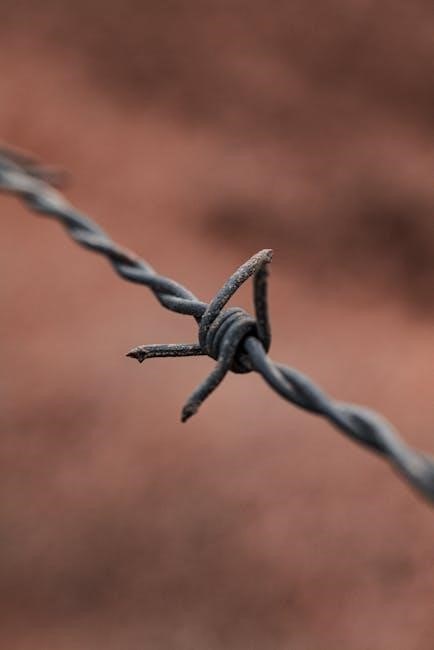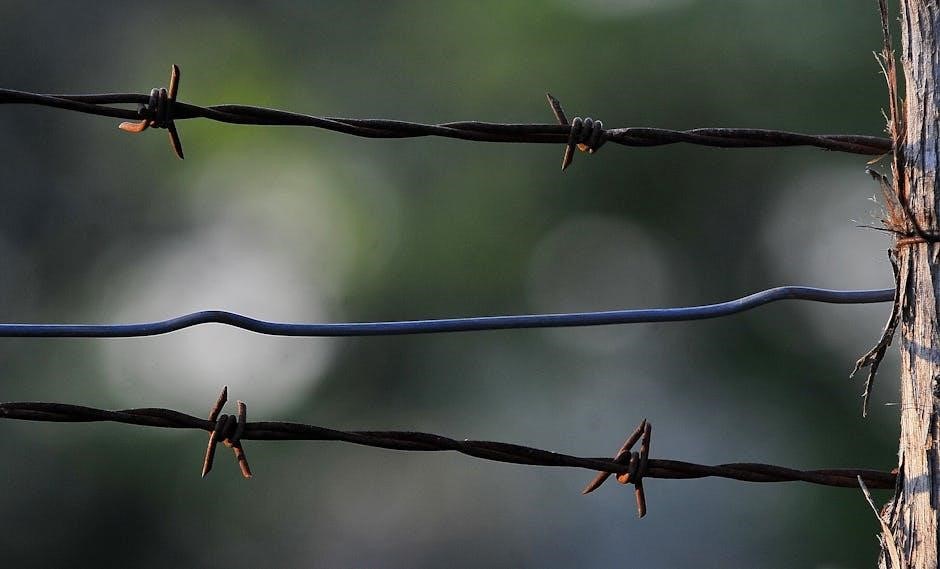Defensive line drills are essential for building strength, technique, and reaction skills in football. They focus on improving stance, footwork, and pass rush effectiveness, ensuring players dominate the line of scrimmage.
1.1 Importance of Defensive Line Drills in Football
Defensive line drills are vital for developing the physical and technical skills needed to control the line of scrimmage. They enhance strength, agility, and reaction time, enabling players to effectively stop runs, rush the passer, and disrupt offensive plays. Consistent practice builds discipline and ensures defensive linemen can perform at peak levels during games.
1.2 Key Objectives of Defensive Line Training
Defensive line training aims to improve stance, footwork, and hand placement while enhancing gap control and block-shedding techniques. It focuses on developing pass rush moves, tackling proficiency, and reaction to offensive schemes. The primary goal is to create a dominant, disciplined unit capable of disrupting plays and maintaining defensive integrity consistently during games.

Essential Pre-Practice Drills for Defensive Linemen
Pre-practice drills for defensive linemen focus on improving stance, footwork, and reaction. These drills include alignment assessments, two-step drills, and error correction to prepare for effective gameplay.
2.1 Two-Step Drill for Stance and Footwork

The two-step drill enhances defensive linemen’s stance and footwork. Players start in stance, step forward 6 inches on the snap, and throw hands upward, palms together. They land on their chest and check foot placement before rising. This drill improves reaction, balance, and explosiveness, preparing linemen for game situations and effective engagement.
2.2 Alignment Assessment Drill
The alignment assessment drill evaluates defensive linemen’s ability to position themselves correctly before the snap. Players line up according to the coach’s instructions, ensuring proper stance and alignment. The drill checks foot placement, hand positioning, and readiness to engage blocks. It reinforces pre-snap discipline and prepares linemen to react effectively to various offensive schemes.
2.3 Common Errors to Avoid in Defensive Line Stance
Common errors in defensive line stance include feet too wide or narrow, hands misplaced, and improper weight distribution. Players often lean forward, putting pressure on their toes, or stand too upright, reducing explosiveness. Coaches must emphasize proper alignment, balance, and a consistent base to maintain readiness and effectiveness in engaging blocks and reacting to plays.
Pass Rush Drills for Defensive Linemen
Pass rush drills focus on refining techniques like rip, swim, bull, and club moves. They enhance acceleration, hand placement, and overall effectiveness in pressuring quarterbacks during games.
3.1 Pass Rush Moves (Rip, Swim, Bull, Club)
Pass rush moves like rip, swim, bull, and club are fundamental techniques for defensive linemen. The rip move uses an inside arm to defeat blocks, while the swim move employs a cross-body motion to clear contact. The bull rush overwhelms blockers with raw power, and the club move disrupts timing with a precise forearm strike. These moves are essential for pressuring quarterbacks effectively and consistently.
3.2 Long Drill for Acceleration and Hand Placement

The Long Drill focuses on enhancing acceleration and precise hand placement. Players explode forward with a hard step, replacing their down hand, and extend their inside arm into a pad or during a circle drill. This drill improves explosiveness, technique, and the ability to maintain balance while rushing the quarterback effectively.
3.3 Pass Rush Under the Chute (PUC) Drill
The Pass Rush Under the Chute (PUC) Drill involves a defensive lineman rushing through a chute, focusing on maintaining low pad level and active hands. Players explode from their stance, keeping elbows tight and hands inside. This drill simulates game-like conditions, helping linemen improve leverage, balance, and hand placement while engaging blockers effectively.

Tackling and Pursuit Drills
Tackling and pursuit drills refine defensive linemen’s ability to stop ballcarriers and pursue plays relentlessly. These drills focus on proper tackling form, reaction speed, and relentless effort to the ball.
4.1 Form Tackle Execution on a Dummy
Form tackle execution on a dummy teaches defensive linemen proper tackling technique. Players start in a stance, explode forward, and lead with their shoulder, wrapping arms around the dummy. Coaches emphasize keeping the head up, eyes open, and driving through with the hips to ensure a safe, effective tackle.

4.2 Pursuit and Tackle Fundamentals
Pursuit and tackle fundamentals require defensive linemen to aggressively chase the ball carrier while maintaining proper tackling form. Players must stay disciplined in their pursuit angles, keep the ball carrier in front, and execute safe, effective tackles by leading with the shoulder and wrapping up. Coaches emphasize effort, intensity, and proper technique.
4.3 Ball Drop and Reaction Drill
The ball drop drill enhances reaction skills by simulating game situations. A coach drops the ball, and defensive linemen react quickly, identifying the ball carrier. Players must explode off the line, pursue at proper angles, and execute tackles with safe, fundamental form. This drill emphasizes quick decision-making and immediate response to ball movement.
Reaction and Block Shedding Drills

These drills focus on improving defensive linemen’s ability to react to plays and shed blocks effectively. Players learn to recognize run/pass, attack blocks decisively, and maintain gap integrity, enhancing their instincts and technique for game scenarios.
5.1 Run/Pass Recognition Drill
This drill enhances defensive linemen’s ability to quickly identify run or pass plays. Players start in stance, react to coach’s signals, and execute proper techniques. For runs, they attack gaps decisively; for passes, they rush the quarterback. Coaches emphasize reading offensive lineman movements and maintaining footwork precision to improve instincts and reaction speed effectively.
5.2 Two-Man Sled Drill with Pass React
This drill involves two defensive linemen aligned against a sled. On the coach’s signal, they react to either a run or pass scenario. Players practice shedding blocks or rushing the quarterback, focusing on proper footwork and hand placement. The drill simulates game-like situations, improving reaction time and technique for both run and pass defense effectively.
5.3 Mirror Drill for Block Attack
In the Mirror Drill, two defensive linemen face each other, mirroring movements. One acts as the blocker, the other as the defender. They engage, focusing on hand placement, footwork, and shedding blocks. This drill enhances reaction time, balance, and the ability to counter various blocking techniques effectively in game situations.

Offseason Workout Plan for Defensive Linemen
An effective offseason plan includes core strengthening, lower body exercises, agility drills, and pass rush technique refinement. This comprehensive approach ensures defensive linemen maintain peak performance during the season.
6.1 Core and Lower Body Strengthening Exercises
Core and lower body exercises are essential for defensive linemen, enhancing explosiveness and stability. Squats, deadlifts, and lunges build leg strength, while planks and Russian twists improve core stability. These exercises, performed 4 times a week, help players maintain proper stance and generate power for effective blocks and tackles during games.
6.2 One-on-One Drills with Offensive Linemen
One-on-one drills pit defensive linemen against offensive linemen, simulating game scenarios. These exercises focus on pass rush moves, block shedding, and reaction skills. Conducted for 30 minutes, they help refine technique, improve strength, and enhance competitiveness. Players alternate pass rush moves like rip, swim, and bull, fostering intensity and precision in their execution.
6.3 Bag Drills for Agility and Speed
Bag drills enhance agility and speed by navigating through a row of bags. Players perform 5 sets, alternating pass rush moves like rip, swim, and bull. This improves footwork, quick direction changes, and acceleration. Emphasis is placed on maintaining proper technique while building explosive power and reaction time for on-field effectiveness.

Advanced Defensive Line Techniques
Advanced techniques refine gap control, hand placement, and footwork precision. Drills like ladder exercises and reaction training enhance speed and agility, preparing linemen for complex game scenarios.
7.1 Defensive Line Tips for Gap Control
Proper gap control is crucial for defensive linemen to stop runs and pressures. Tips include staying low, using hands to control blockers, and maintaining balance. Align feet shoulder-width apart, knees bent, and weight forward. React quickly to the ball’s movement, ensuring gaps are filled decisively. Pre-snap alignment and foot placement are key to dominating the line of scrimmage effectively.
7.2 Bob and Swat Technique Drill
The Bob and Swat drill enhances a defensive lineman’s ability to react to blockers. Players start in a stance, then “bob” laterally to avoid contact. They quickly “swat” the blocker’s hands away, creating separation. This drill improves hand placement, footwork, and reaction time, preparing linemen to effectively shed blocks and dominate in game situations.
7.3 Ladder Drills for Footwork Precision
Ladder drills are essential for refining a defensive lineman’s agility and footwork. Players weave through ladders using patterns like high knees, lateral shuffles, and carioca drills. These exercises enhance quickness, balance, and coordination, translating to faster movements on the field and better positioning to outmaneuver blockers during games.
Coaching Points and Safety Considerations
Proper stance, hand placement, and body positioning are critical for effective defensive line play. Coaches must emphasize controlled contact, helmet safety, and injury prevention during drills to ensure player well-being while maintaining high performance levels.
8.1 Proper Stance and Foot Placement
Proper stance and foot placement are the foundation of defensive line play. Feet should be shoulder-width apart, knees bent, and weight evenly distributed. Hands should be ready to engage, with elbows tucked and eyes forward. Coaches must ensure consistency in stance to maximize explosiveness and reaction. Proper alignment prevents injuries and enhances performance.
8.2 Hand Placement and Elbow Positioning
Hand placement and elbow positioning are critical for effective engagement. Hands should hit palms together with thumbs up, elbows tucked to generate power. Keeping elbows close to the body prevents overextension and improves leverage. Proper positioning ensures control, allowing linemen to shed blocks and maintain balance during contact.
8.3 Safety Guidelines for Contact Drills
Ensure all players wear proper pads and helmets during drills. Emphasize controlled movements to prevent unnecessary contact. Drills should be supervised by coaches to enforce safety protocols. Teach proper tackling and blocking techniques to minimize injury risks. Focus on staying low and using hands effectively to maintain balance and avoid dangerous collisions.
Defensive line drills are crucial for player development. Consistent practice and proper technique ensure success. For further improvement, explore recommended PDF resources and video clinics offering detailed drills and coaching tips.
9.1 Summary of Key Defensive Line Drills
Key defensive line drills include stance and footwork exercises, pass rush techniques, block shedding, and tackling practices. These drills enhance strength, agility, and reaction skills, preparing players for game scenarios. Regular practice of these drills ensures improved performance and dominance on the field, covering essential aspects of defensive line play.
9.2 Recommended PDF Resources for Further Practice
Recommended PDF resources include “50 Defensive Football Drills” and “Defensive Line Drill Library.” These guides offer detailed drills, coaching tips, and practical exercises to enhance technique, strength, and game performance. They are ideal for coaches and players seeking advanced training methods to excel in defensive line play.
